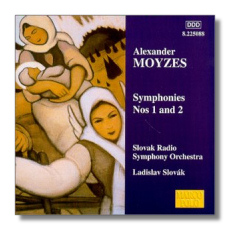
The Internet's Premier Classical Music Source
Related Links
- Latest Reviews
- More Reviews
-
By Composer
-
Collections
DVD & Blu-ray
Books
Concert Reviews
Articles/Interviews
Software
Audio
Search Amazon
Recommended Links
Site News
 CD Review
CD Review
Alexander Moyzes

Symphonies
- Symphony #1, in D Major, Op. 31
- Symphony #2, in A minor, Op. 16
Slovak Radio Symphony Orchestra/Ladislav Slovak
Marco Polo 8.225088 78:05
Alexander Moyzes (1906-84) came from Northern Slovakia and was an exact contemporary of Dmitri Shostakovich. Of course, he never even approached this Russian composer in fame. This was my first exposure to his music and frankly I was greatly impressed. His First Symphony (1929; rev. 1937) shows great skill, as few who hear this work can deny. This composition was only held back, I'll surmise, because of its conservative expressive language. It might have been written thirty or forty years earlier when Richard Strauss was making his mark and Mahler was just coming on the scene. Yet, there is nothing imitative in any obvious way in the music.
The First Symphony is cast in four movements and has a duration of 41:11, with only one brief movement – the Scherzo third (5:19). The first movement is a powerful post-Romantic statement, full of color and drama. The ensuing Adagio is deftly orchestrated and offers perhaps the deepest music, though I wouldn't characterize it as profound. Rachmaninoff and early Sibelius may come to mind here, but in his slight exoticism and Slovak nature Moyzes still sounds sufficiently different from them. The Scherzo is a delightful playful movement, especially in its last half, and the finale, after a slow opening, delivers a powerful and colorful close. The orchestration in this last movement is particularly imaginative and brilliant. When Moyzes revised this symphony in 1937 he designated it his "Opus 31", thus accounting for the higher numbering than that of the Second, which retained the same opus number when it was reworked.
Speaking of the A minor Symphony (1932; rev. 1941), it is cast in two long movements, both bearing Allegro markings, though there is slow music within each. It is another finely-crafted work, featuring an opening that is probably coincidentally similar in style to the music of Vaughan Williams and Bax. On the whole, the symphony is quite inventive and colorful, again in a conservative vein. It is rather episodic, but generally quite effectively so.
All in all, these two symphonies comprise one of the more engaging discoveries in the last decade or so. I would rank Moyzes easily with the second-tier composers of the 20th century, like Martinů, Bax, Rodrigo, and perhaps even with some of the front-rank ones.
The performances from the Slovak Radio Symphony are excellent, showing commitment that only countrymen can give in the music of lesser-known and less-played composers. Conductor Slovak incisively reads the scores, effectively capturing their Slovak character and color. Excellent sound (from recordings made in 1993 and 1994 – why the wait?) and intelligent notes are provided by Marco Polo. It's occurred to me that this is the first recording I know of by a Slovak composer played by the Slovak Radio Orchestra, under the direction of Slovak.
Copyright © 2000, Robert Cummings


















